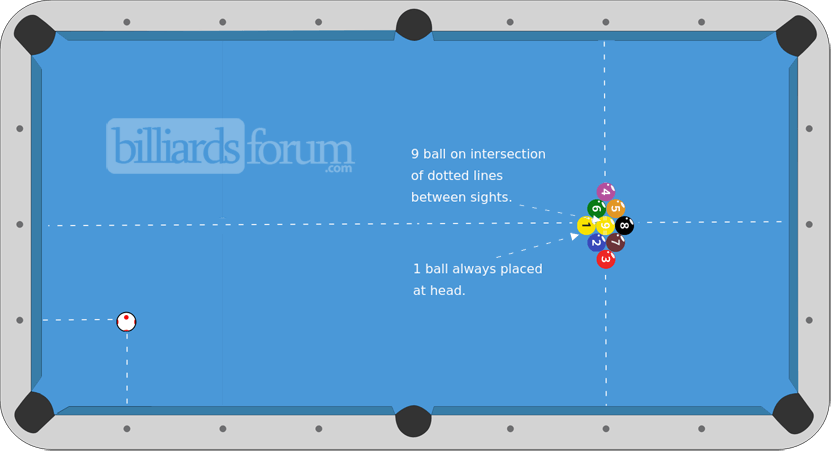Texas One Shot Rules
Learn how to play a new game that is a twist on traditional 9 ball pool, called Texas One Shot.

In this section you'll learn how to play Texas One Shot pool.
Rules for Texas One Shot Pool
Texas One Shot is a game that is based on 9 ball pool but the reward system is different.
The only way to continue your inning at the table is to move the 9 ball after first striking the lowest ball on the table with the cue ball.
Here are some of the main differences between 9 ball and Texas One Shot:
Continuing Play:
- In 9-Ball a player is rewarded an additional shot every time the player pockets one or more balls.
- In Texas One Shot a player is rewarded an additional shot if the player makes the 9-Ball move after first striking the lowest ball on the table with the cue ball.
Winning the Game:
- Pocketing the 9-ball on a legal shot wins the game.
- In Texas One Shot the only ball that is rewarded for going into a pocket is the 9-ball and victory is the reward.
It is fine to pocket other balls and doing so may or may not be to a players advantage but a player is only rewarded another shot for moving the 9-ball as described above.
In summary:
- If you move the 9-ball, then you shoot again
- 9-ball does not move - your turn is over. Playing defense can be a smart way to go.
Racking the Balls
Racking the balls for Texas One Shot pool is done with a standard 9-ball rack, but rotated 90 degrees. The creators of the game call this rotated 9 ball rack "The Phat Rack".
The 1-ball is placed at the new head of the rack and the 9-ball is placed on the spot.

Care should be used to ensure the rack lines up with the center sights at the head and foot of the pool table and with the second sights from the foot of the table on the side rails.
Pro Tip: A tight rack is easier to accomplish from the either side of the table than from the foot of the table. This is because racking from the side of the pool table is much easier than from the foot of the table and typically produces a tighter rack.
The Break Shot
Players are required to "square up" to break. Instead of breaking from a side rail as is common in 9 ball pool, the player is required to break from the "center square" as defined by the first sight in from the side rails at the head of the table and the second sight down each side rail from the head of the table.
From the game creator's FAQ:
To discourage hacking of the Phat Rack players are required to break from the square defined by the first diamond in from each side at the head of the table and the second diamond down each rail from the head of the table. So always Square Up before the break, it’s the right thing to do.
In Texas One Shot pool, players are required to break "with force" within the player’s capability. A "soft break" is not permitted.
During every break shot, the 9 ball is "deemed to have moved by definition" (see below), meaning the breaking player shoots again. The only exceptions to this are:
- If the player pockets the 9 ball on the break (and thus, wins the game).
- If the player scratches on the break shot (which results in the end of the inning for that player).
9 Ball "Deemed to Have Moved by Definition"
On the break, the 9-ball is deemed to have moved "by definition". Even if the 9-ball remains on the spot, energy from the object balls touching it passed thru the ball and it is deemed to have moved. This principle is used throughout the game—if energy passes through the 9 ball, it is deemed to have moved.
On the contrary, if a ball is touching the 9-ball and all the energy is directed away from the 9-ball it is deemed to have not moved.
Therefore, if the cue ball is touching the 9-ball but the shot is directed away from the 9-ball and makes legal contact with the lowest ball on the table, no foul has occurred.
If an object ball touching the 9-ball moves and all the energy is directed away from the 9-ball the 9-ball is deemed to have not moved.
The Concept of "Putting"
A common rule in 9-Ball to prevent the easy snookering of an opponent is that after the lowest numbered ball on the table is first struck by the cue ball, a ball must be driven to a rail or a pocket for the shot to be legal.
The same rule applies in Texas One Shot, but with one exception. That is, if the 9-ball is "deemed to have moved".
If the 9-ball moved, it is still the shooting player's shot (as a player could only snooker one's self if there is no foul). Generally the play would be used to get into position for a winning shot.
In Texas One Shot, this is called "putting", and is allowed.
A player may use multiple "putts" to position themselves for a win. Being able to softly set yourself up for a winning shot is encouraged in Texas One Shot, and is not a foul!
Fouls and Spotting the 9 Ball
If at anytime during a game the 9-ball is pocketed on a scratch or illegal shot, the 9-ball is spotted on the foot spot and the opponent is given ball in hand.
This occurs when a player scratches or commits a table foul.
The Last Ball
Care should be taken when there is but one object ball left on the table.
If the last object ball is pocketed and the 9-ball is "deemed to have moved" during that shot, the shooting player is typically set up to win the game. This is because they may continue to make multiple shots, as long as the 9-ball moves, to pocket the 9-ball.
If a player pockets the last object ball but and fails to move the 9-ball in that same shot, the player's turn is over resulting in the opponent virtually being guaranteed a win (because as long as your opponent legally moves the 9-ball they may shoot until they win).
Texas One Shot Rules
If you have any questions about Texas One Shot Rules, please post them in the pool rules forum.
Texas One Shot Rules History
The game "Texas One Shot" was created in Austin, TX in February 2021 during Winter Storm Uri (February 13th - 17th).
After many hours of testing it was presented to BCA Rules Master Randy "Pops" Geottlicher (pronounced "get liquor"). After watching several matches played, Randy found the game interesting enough to organize a Texas One Shot pool tournament, which was held in July of 2022, with a group of his best BCA instructors to see if they could break the game. Texas One Shot passed the test.
After many more hours of play the 90° rotated 9-ball rack scheme was introduced to the game.
Texas One Shot made it's public debut in the Fall of 2022 and was soon being played in pool halls around Austin, TX such as The Grand, Slick Willie’s, and of course Skinny Bob’s. It has now been played in every major pool hall in Austin including Betsy's, Clicks, Fast Eddie’s, The Warehouse, and Eddie’s Tavern.
The copyright to the game is owned by Twisted Texas Style, LLC, which is based in Austin, TX.
Texas One Shot has it's own companion website at tx1shot.com with rules, videos, merchandise, and other information about Texas One Shot.
The official Texas One Shot Rules are predominently observed in North America (Texas, specifically).
The official governing body for Texas One Shot Rules is the Twisted Texas Style, LLC.
How to Play Texas One Shot
- Title: Texas One Shot Rules
- Author: user1691693424
- Published: 11/1/2023 6:53:37 AM
- Last Updated: 11/3/2023 5:29:53 AM
- Last Updated By: billiardsforum (Billiards Forum)
Texas One Shot Rules
The Texas One Shot Rules article belongs to the Pocket Billiards Rules category. Pocket billiards is a class of cue sport game commonly referred to as pool.
Texas One Shot Rules Comments
There are not yet any comments. Please post one below. All comments are moderated.
Reply and share your comments below:
